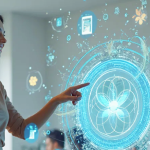The capacity of artificial intelligence (AI) to diagnose or predict disease risk is developing rapidly.
We have already seen models that scan retinal images to predict eye- and cardiovascular-disease risk, and that analyze mammograms to detect breast cancer, among others. In fact, recently the US Food and Drug Administration has approved an artificial intelligence diagnostic device that doesn’t need a specialized doctor in order to detect diabetic retinopathy, a very specific eye disease.
Does this mean that machine learning diagnostics are here to replace those of doctors? Not at all—more realistically, this technology can be used as a tool by doctors to help them reduce human error, save time, and achieve more accurate diagnoses.
What is the best use for AI in healthcare?
Already artificial intelligence systems are capable of helping diagnose very specific pathologies, but physicians must still give their input. Doctors still come first in understanding the context of the patient’s condition and which of these pathologies to check for.
Another aspect of machine learning is that understanding “why” the technology makes a particular decision is very opaque. Even when we can extract “what” it took into consideration, we can’t necessarily find its rationale. Its solutions learn by example rather than by a set of hardcoded rules. This is both a blessing and a curse. And this same evidence-based approach is much harder to apply to patient care than to other mature fields like drug development.
That is why for only very specific conditions would we trust a machine learning system to produce a diagnosis without supervision. We should not expect an this technology to be the doctor, but rather to be a very sophisticated instrument that can supersede the need of a judgement call from a doctor on a tightly bound problem, as many medical instruments of the past have done. There are already other machines and analyses that we currently trust to determine whether a patient has a disease. Think X-rays for detecting a fracture, or the development of ultrasound technology.
For instance, take this investigation published in 2017. It found that an artificial intelligence model detected breast cancer in whole-slide images better than 11 pathologists. They all had about one minute to look at each image. However, given unlimited time, the pathologist performed just as well, and moreover found difficult-to-detect cases more often than the computers.
The future: adoption and adaptation
Adoption and adaptation of artificial intelligence in healthcare are not optional. If people are willing to webMD their symptoms instead of going to a doctor, what is going to dissuade them from using a “play” diagnostic app? To bolster trust, relevance, and the true value of scientific medicine, institutions must embrace this technology across tools and disciplines. It is slowly drifting to the core of many experts’ judgement calls. It’s imperative to prepare and prescriptively adapt to AI to keep the most positive landscape for the industry and society.
This post is the second in a healthcare series we are working on. Look here for the first post.




